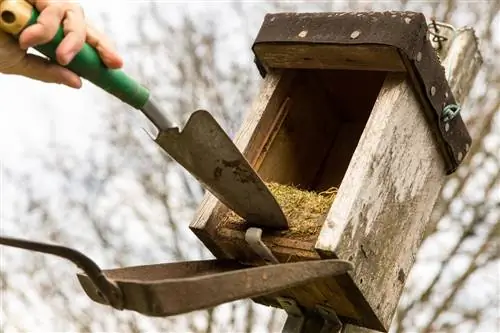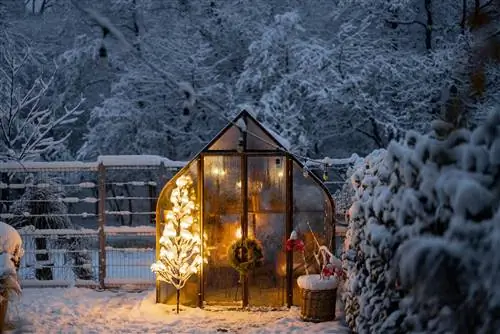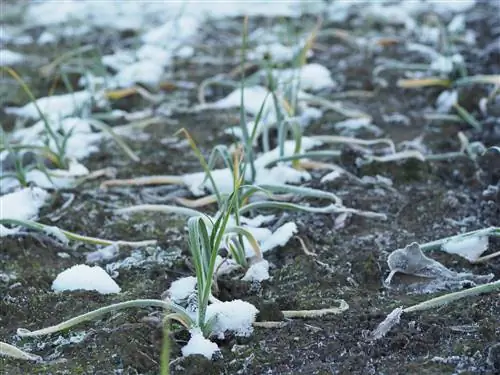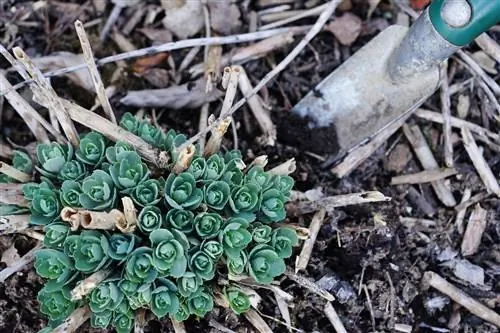- Author admin [email protected].
- Public 2023-12-16 16:46.
- Last modified 2025-06-01 06:02.
November is still enough time to plant bulbous plants such as tulips and daffodils. Perennials can still be planted during frost-free periods. If there was no long-lasting frost period in October, now is the time to overwinter potted plants and bedding plants that need protection and put them in their winter quarters.
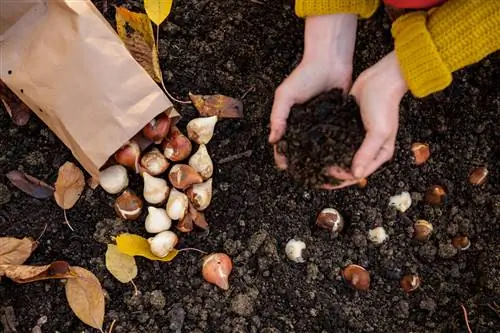
What are the most important gardening tasks in November?
The following garden work should be done in November: sowing cold germs and robust vegetables, harvesting the last winter vegetables, planting perennials, fruit trees, berry bushes, ornamental trees and roses, propagating with cuttings, cutting trees and other tasks such as emptying beds, Composting, cold frame preparation and piling up roses.
Summary
The gardening year ends in the gray drizzle of November. There is little left to do, these final touches and tasks are waiting for you.
- Sowing: Cold germinators for the following year, some robust vegetables in the greenhouse and on the windowsill
- Harvesting: harvest the last winter vegetables in time before the first frost, frost-tolerant varieties such as Brussels sprouts and kale can be left outside all winter (if necessary with protection)
- Plants: robust perennial herbs, fruit trees, berry bushes, ornamental trees, roses, climbing plants, frost-hardy flower bulbs
- Propagate: Cuttings
- Cutting: Woody plants can be cut as long as there is no frost
- Other gardening work: Clearing the beds, setting up compost, digging and preparing cold frames, piling up roses
Sowing in November
November is not a typical month for sowing seeds. However, you can still sow seeds even this late in the year and prepare for the following year. The seeds planted now will not expire until next spring, but you can harvest and enjoy them earlier.
- Sowing outdoors: In November, when the weather is mild, cold germinators can be sown outdoors and they will then sprout the following year. Vegetables suitable for this purpose include parsnips (Pastinaca sativa), early carrots (Daucus carota subsp. sativus), chervil beets (Chaerophyllum bulbosum) and sea kale (Crambe maritima).
- Sowing in the greenhouse: You can also sow garden cress (Lepidium sativum) and lamb's lettuce (Valerianella locusta) in the greenhouse.
- Sowing on the windowsill: Cress and so-called microgreens thrive on the windowsill - sprouts grown from normal vegetable seeds that provide fresh vitamins in winter.
Harvests in November
If the last weeks of October were mild, the winter vegetables are often still in the bed in November. Now, however, it is high time to plant frost-sensitive winter vegetables like
- Carrots
- Celery
- Beetroot
- Leek
- or chicory
harvest and store in the cellar, wrapped in moist sand. The last remaining heads of red and white cabbage and savoy cabbage should now be brought to safety. Endive, sugar loaf and broccoli should also be harvested and stored now. However, these vegetables are a little less sensitive and can stay outside a little longer if covered with winter fleece.
As long as the ground is not yet frozen, also dig up root parsley and horseradish for winter supplies. If sown in good time - in September or October at the latest - you can now also bring vitamin-rich greens such as parsley, spoonwort, St. John's wort and winter purslane into your kitchen.
These vegetables can still stay outside
Lamb lettuce and the red chicory lettuce 'Red Veronese' stay outside all winter, but are covered with some protective pine branches. Brussels sprouts and kale are also tough: they even need a few weeks of cold weather to taste really good.
Tip
Dig up a strong ball of chives and leave it on the bed. Only when it is completely frozen do you pot it in fresh soil and bring it into the house on the windowsill.
Plants that bloom in November
This late in autumn, some asters, such as the myrtle or heather aster, as well as chrysanthemums, give us the very last joy of blooming. The colorful flowers even survive the first frosty nights if you cover the plants with a fleece overnight. A chrysanthemum bouquet brought into the house before the frost lasts quite a long time in the vase.
Planting and propagating in November
- Perennials and trees: If the weather is frost-free, all kinds of trees and herbs and perennials can still be planted in November. Robust perennial herbs such as oregano, lovage, mugwort and comfrey can now be added to the bed. Fruit trees and berry bushes can still be planted. Tie the young trees to a strong stake so that they are not broken by autumn and winter storms. Even roses, ornamental shrubs and climbing plants as well as hornbeams - the latter for a hedge, for example - can still be planted this late in the year. If the weather is favorable, the planting season for perennials continues into November.
- Flower bulbs: Don't be afraid to put the last flower bulbs in the ground. These are often available quite cheaply in garden stores in November. You have until around the first Advent to do this - of course, as long as the weather cooperates and is mild enough. These late-planted spring bloomers will need some time to get going and will sprout later, but you will be able to enjoy beautiful tulips, daffodils and the like for longer.
- Propagate: If you want to plant or transplant perennials, you can now propagate large specimens by dividing them. However, do not divide the plants too late: they should still have a chance to grow in their new location well before the first frost. If you now grab the secateurs and cut back trees, you can use the clippings for cuttings. However, cuttings are no longer cut in November.
Cutting in November
On cold, dry November days, you can start thinning out old fruit trees and berry bushes. All trees can still be cut as long as there is no frost and the temperatures are mild. However, you should not cut perennials, ornamental grasses and especially roses before winter.
Plant diseases and pests in November
Basically, November is a bad month for pathogens and pests. These have usually already retreated to hibernate for the winter. For example, when working on the beds or on the compost, look out for snail eggs that lie close together like white pearls. Remove and dispose of them! Also pay more attention to mice, rats, voles or martens. These animals do not hibernate and increasingly seek proximity to humans in winter. You will find a lot of food here. The following preventative measures keep the pests away:
- Closing gaps and garden houses etc.
- Keep garbage cans and compost well closed
- Do not store supplies openly, especially a. no grain
- on signs of construction, e.g. B. hidden holes, pay attention
More gardening work in November
However, the gardening work mentioned is far from over in November. Other tasks primarily concern preparatory activities - for the cold season as well as for the coming spring and thus for the new garden season.
- DO NOT cut roses: First of all: Please never cut roses in autumn! Otherwise you run the risk of the sensitive bushes freezing and no longer sprouting next year. With uncut roses, however, you can easily cut away all the frozen branches after the winter and there will still be enough he althy wood left for new growth.
- Piling up roses: Pile up your roses now in November with garden soil or compost. This protects the grafting area and the branch bases from frost. In colder locations it is also helpful if you also cover the bushes with spruce branches. Climbing roses on house walls are exposed to extreme weather, so you should tie spruce branches to the long shoots here. However, standard roses are particularly at risk because the grafting point for them is not in the ground. You must wrap this sensitive area at the base of the crown thickly with wood wool or straw and then tie the crown loosely with spruce branches. Special cold protection hoods, for example made of jute, are also available in stores.
- Winter protection for pampas grass: Pampas grass is a popular ornamental grass and can be found in many gardens. The grass is native to the South American steppe and reacts quite sensitively to wet feet in our Central European winter. Therefore, tie the long stalks together like a ponytail, then the rain will be diverted to the outside and the heart of the perennial will remain dry. As a precaution, you can pile up a warm layer of leaves around the plant to protect against the cold.
- Plant protection measures: In general, there is still some work to protect the plants in November. This also includes collecting and disposing of fallen fruit and fruit mummies as well as diseased leaves. In this way you prevent fungi and bacteria from surviving in the soil and thus avoid possible new infections in the spring. Mulched areas - such as under trees or in flower borders - can be covered with a few shovels of soil. Pots with frost-hardy plants, such as fruit or perennial herbs, should be pushed close to a heat-emitting house wall and placed on a wooden base.
- Help for wildlife: Leave leaves and woody debris wherever possible. This is how useful garden helpers - such as hedgehogs - find winter quarters. Wild berries and seed heads now serve as food for the birds. Butterflies and lacewings seek shelter in the garden shed and in the attic. So don't tidy up your garden unnecessarily anymore.
- Preparing cold frames and hilled beds: As long as the ground is not frozen, you can also do the initial preparatory work for next year's cold frames and hilled beds. For the cold frames, dig pits about 60 to 70 centimeters deep, storing the soil next to the box during the winter months. This way it freezes beautifully and becomes so finely crumbly. Fill the pit you have dug with leaves and close the windows of the cold frame. Finally, in February, horse or cattle manure can go in. Since large amounts of organic waste accumulate in the fall, you can start piling up a mound bed on dry days. This can then be planted in spring.
- Create compost: November is also the right time to put the garden waste piled up in the fall into a compost heap. If you have enough space, the organic material can also be neatly stacked in silos or wooden layers. It is important to shred all waste beforehand and mix it thoroughly so that enough air can always circulate. If it rains heavily in November, cover the fresh compost. This will prevent it from getting wet and rotting.
FAQ
What garden work will be done in November?
Harvest the last of the winter vegetables and get your roses into shape. Remove the last fallen fruit, fruit mummies and foliage affected by fungi or bacteria to avoid reinfection next year. Now is also the time to create winter shelters and feeding places for garden creatures such as hedgehogs and birds. Cold frames and hill beds as well as a new compost heap can now be created.
What is sown in November?
Shortly before winter, only cold-germinating species and varieties that need the frost to break the germination inhibition and therefore only sprout next year should be sown outdoors. On the windowsill, however, you can grow fresh vitamins in the form of cress and so-called microgreens. For the latter you can use all vegetable seeds and eat the fresh sprouts on a sandwich, for example.
What to plant in November?
Now in November, flower bulbs are often available particularly cheaply in garden shops. If the weather is mild and the ground is frost-free, you can still plant spring bloomers in the ground until shortly before the first Advent. They will then sprout just a little later next year. Perennials and trees can also be planted until the beginning of November if the weather is mild. Above all, fruit trees, berry bushes, ornamental shrubs, climbing trees, but also roses or a hornbeam hedge can still be planted now.
What will be cut in November?
The last month of autumn is the right time to thin out old trees and other trees. However, you should not cut perennials, grasses and roses in November: you should wait until spring, as the old shoots serve as protection from the cold. If you cut the plants back too deeply before winter, they can freeze completely in frost.
What plants can you propagate in November?
As long as it doesn't freeze and the temperatures are mild, large perennials can be divided and planted until around the beginning of November. If you have carried out a late pruning, the he althy and strong cuttings can be used as cuttings to propagate the plants. Remove the leaves from the 15 to 20 centimeter long cuttings and make sure that there is an eye at the top and bottom. Place it in the soil in the direction of growth and hill it up lightly.



